NISSAN ALTIMA 2002 L31 / 3.G User Guide
Manufacturer: NISSAN, Model Year: 2002, Model line: ALTIMA, Model: NISSAN ALTIMA 2002 L31 / 3.GPages: 249, PDF Size: 2.02 MB
Page 11 of 249

Seat lifter (Driver's seat) (if so
equipped)
Turn either dial to adjust the angle and
height of the seat cushion to the desired
position.
FRONT POWER SEAT
ADJUSTMENT (Driver's seat) (if
so equipped)
WARNING
cDo not adjust the driver's seat while
driving so full attention may be given
to vehicle operation. The seat may
move suddenly and could cause
loss of control of the vehicle.cDo not leave children unattended in-
side the vehicle. They could un-
knowingly activate switches or con-
trols. Unattended children could
become involved in serious acci-
dents.
Operating Tips
cThe motor has an auto-reset overload
protection circuit. If the motor stops dur-
ing operation, wait 30 seconds, then re-
activate the switch.
SPA0099ALRS0016
1-4Seats, restraints and supplemental air bag systems
ZX
Page 12 of 249

cDo not operate the power seat switch for
a long period of time when the engine is
off. This will discharge the battery.
Forward and backward
Moving the switch forward or backward will
slide the seat forward or backward to the
desired position.
Reclining
Move the recline switch backward until the
desired angle is obtained. To bring the
seatback forward again, move the switch
forward and move your body forward. The
seatback will move forward.
Seat lifter (if so equipped for driver's
seat)
Push the front or rear end of the switch up or
down to adjust the angle and height of the
seat cushion.
Lumbar support (if so equipped for
driver's seat)
The lumbar support feature provides lower
back support to the driver. Move the lever
up or down to adjust the seat lumbar area.
LRS0017ARS1035
Seats, restraints and supplemental air bag systems1-5
ZX
Page 13 of 249
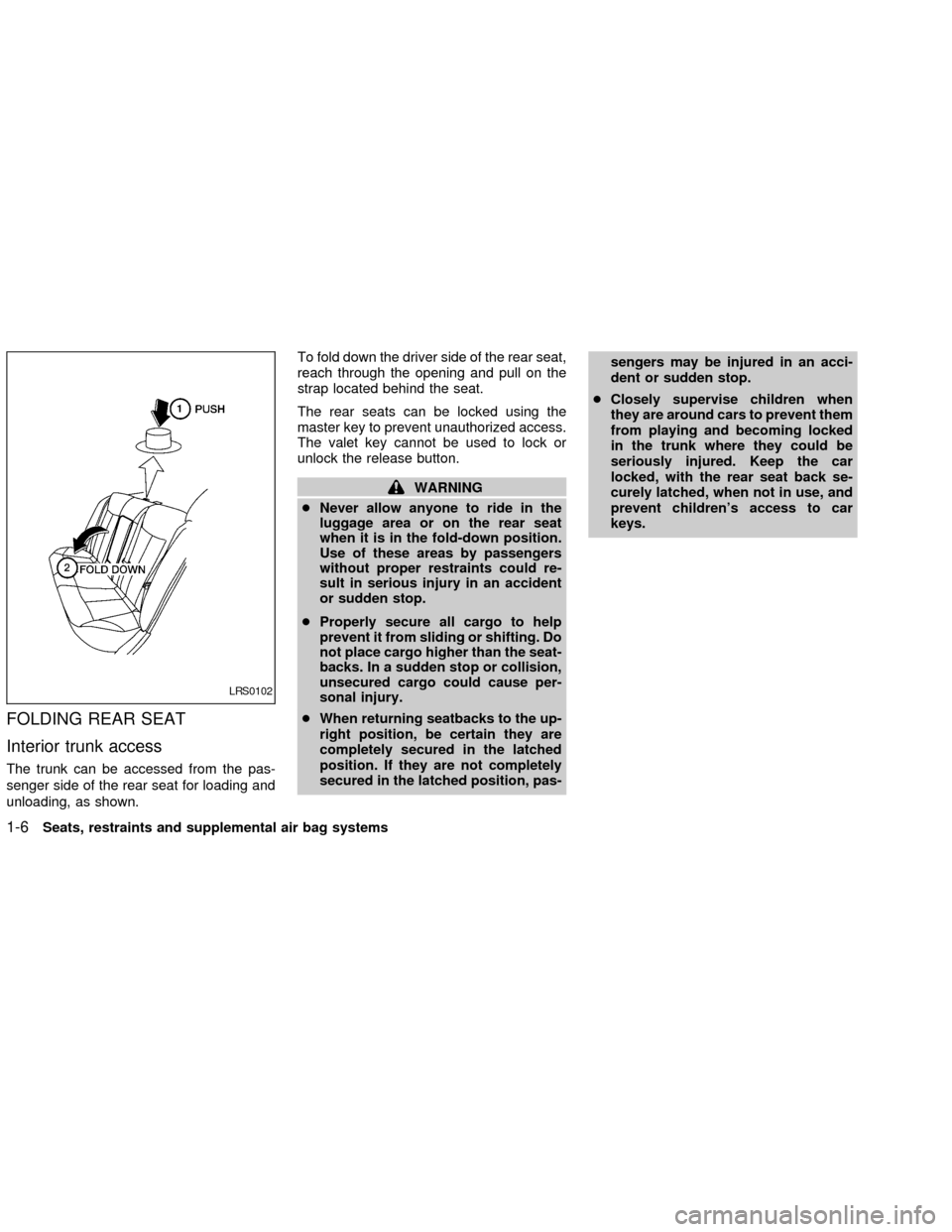
FOLDING REAR SEAT
Interior trunk access
The trunk can be accessed from the pas-
senger side of the rear seat for loading and
unloading, as shown.To fold down the driver side of the rear seat,
reach through the opening and pull on the
strap located behind the seat.
The rear seats can be locked using the
master key to prevent unauthorized access.
The valet key cannot be used to lock or
unlock the release button.
WARNING
cNever allow anyone to ride in the
luggage area or on the rear seat
when it is in the fold-down position.
Use of these areas by passengers
without proper restraints could re-
sult in serious injury in an accident
or sudden stop.
cProperly secure all cargo to help
prevent it from sliding or shifting. Do
not place cargo higher than the seat-
backs. In a sudden stop or collision,
unsecured cargo could cause per-
sonal injury.
cWhen returning seatbacks to the up-
right position, be certain they are
completely secured in the latched
position. If they are not completely
secured in the latched position, pas-sengers may be injured in an acci-
dent or sudden stop.
cClosely supervise children when
they are around cars to prevent them
from playing and becoming locked
in the trunk where they could be
seriously injured. Keep the car
locked, with the rear seat back se-
curely latched, when not in use, and
prevent children's access to car
keys.
LRS0102
1-6Seats, restraints and supplemental air bag systems
ZX
Page 14 of 249
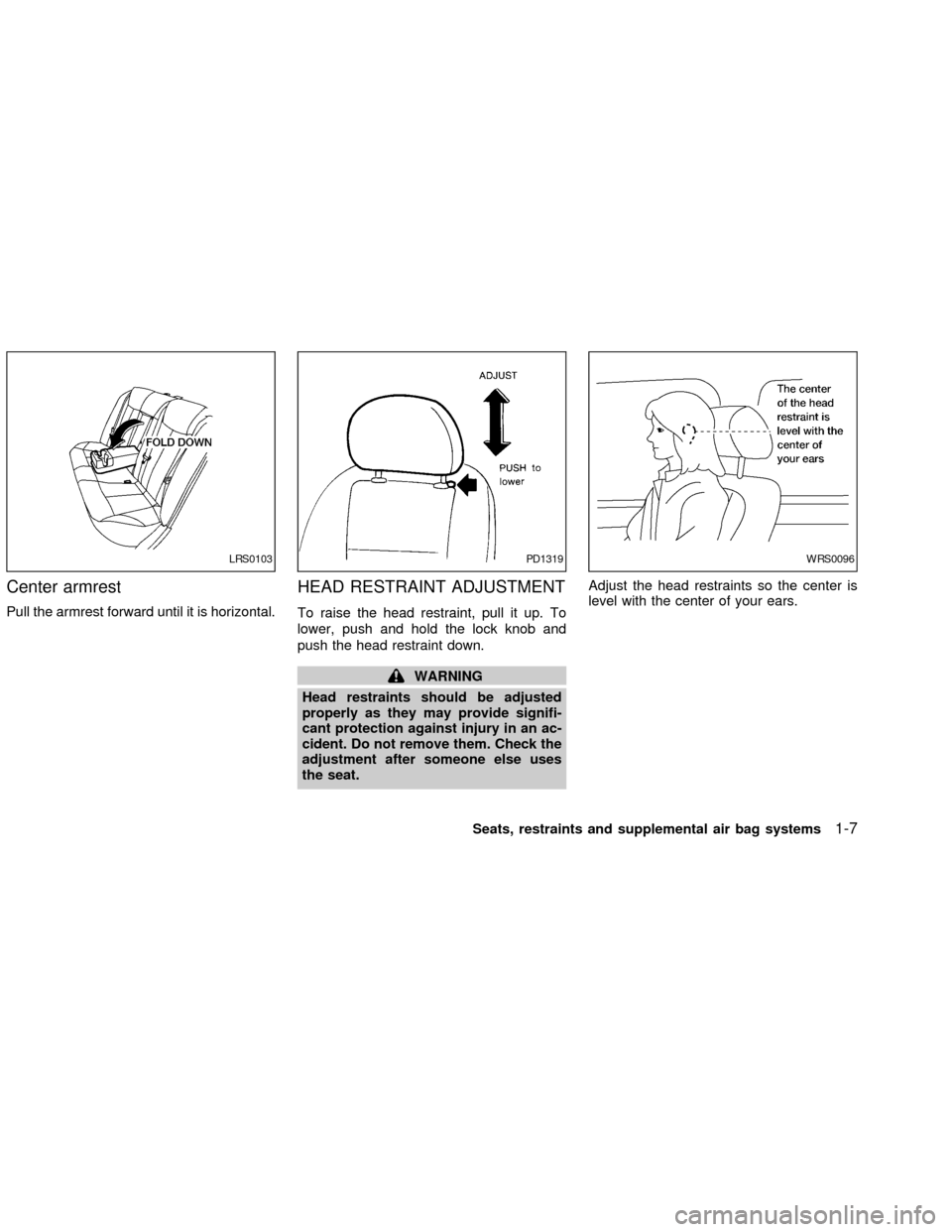
Center armrest
Pull the armrest forward until it is horizontal.
HEAD RESTRAINT ADJUSTMENT
To raise the head restraint, pull it up. To
lower, push and hold the lock knob and
push the head restraint down.
WARNING
Head restraints should be adjusted
properly as they may provide signifi-
cant protection against injury in an ac-
cident. Do not remove them. Check the
adjustment after someone else uses
the seat.Adjust the head restraints so the center is
level with the center of your ears.
LRS0103PD1319WRS0096
Seats, restraints and supplemental air bag systems1-7
ZX
Page 15 of 249

PRECAUTIONS ON SUPPLE-
MENTAL RESTRAINT SYSTEM
This Supplemental Restraint System (SRS)
section contains important information con-
cerning the driver and passenger front im-
pact supplemental air bags, front seat side-
impact supplemental air bags, curtain air
bags and front seat pre-tensioner seat belts.
Front impact supplemental air bag sys-
tem:This system can help cushion the
impact force to the face and chest of the
driver and front passenger in certain frontal
collisions.
Side-impact supplemental air bag sys-
tem:This system can help cushion the
impact force to the chest area of the driver
and front passenger in certain side impact
collisions. The front seat side-impact
supplemental air bags are designed to in-
flate on the side where the vehicle is im-
pacted.
Side impact supplemental curtain air bag
system:This system can help cushion the
impact force to the head of occupants in
front and rear outboard seating positions in
certain side impact collisions. The curtain
air bags are designed to inflate on the sidewhere the vehicle is impacted.
These supplemental restraint systems are
designed tosupplementthe crash protec-
tion provided by the driver and front passen-
ger seat belts and arenot a substitutefor
them. Seat belts should always be correctly
worn and the occupant seated a suitable
distance away from the steering wheel, in-
strument panel and door finishers. (See
``Seat belts'' later in this section for instruc-
tions and precautions on seat belt usage.)
After turning the ignition key to the ON
position, the supplemental air bag warn-
ing light illuminates. The supplemental
air bag warning light will turn off after
about 7 seconds if the systems are op-
erational.
SUPPLEMENTAL RESTRAINT
SYSTEM
1-8Seats, restraints and supplemental air bag systems
ZX
Page 16 of 249
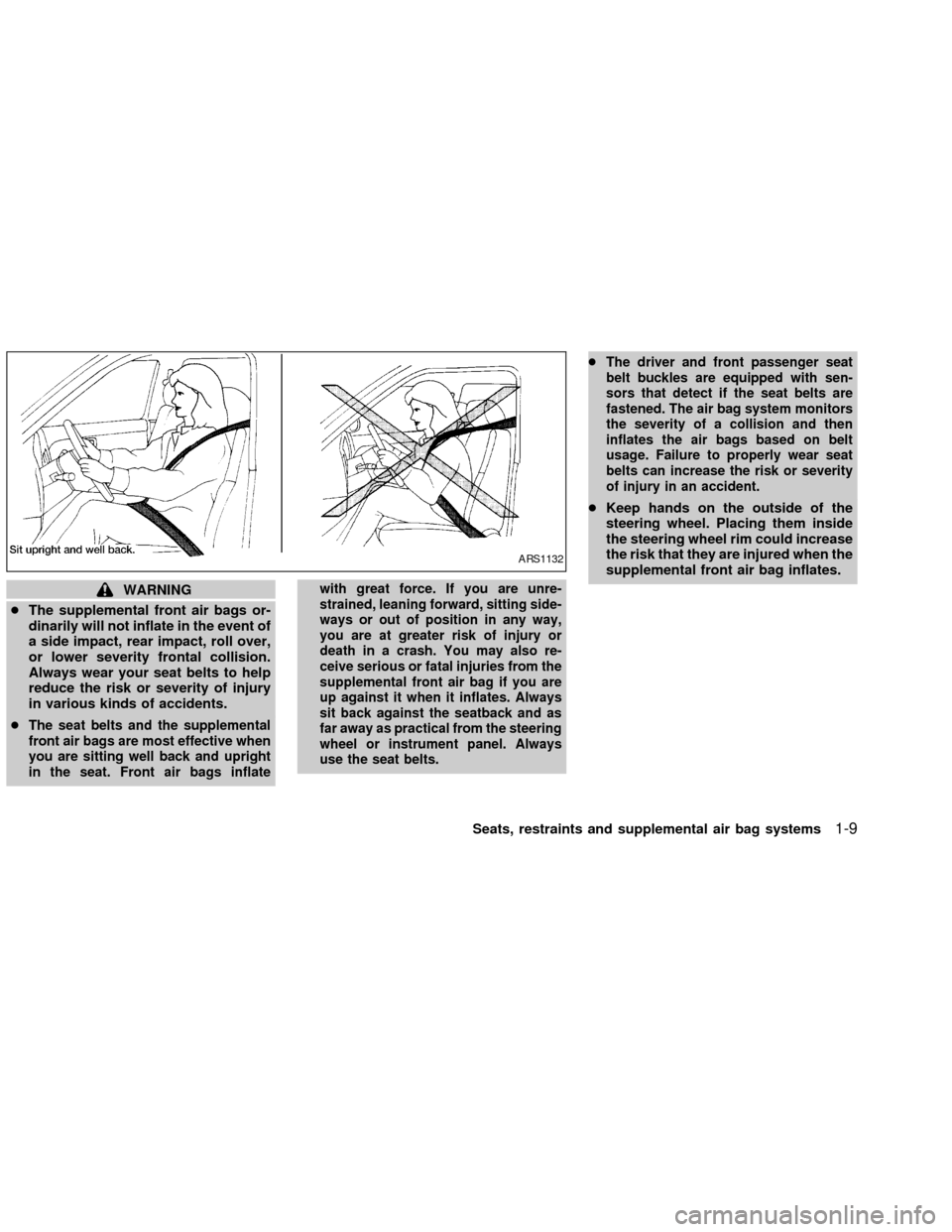
WARNING
cThe supplemental front air bags or-
dinarily will not inflate in the event of
a side impact, rear impact, roll over,
or lower severity frontal collision.
Always wear your seat belts to help
reduce the risk or severity of injury
in various kinds of accidents.
c
The seat belts and the supplemental
front air bags are most effective when
you are sitting well back and upright
in the seat. Front air bags inflatewith great force. If you are unre-
strained, leaning forward, sitting side-
ways or out of position in any way,
you are at greater risk of injury or
death in a crash. You may also re-
ceive serious or fatal injuries from the
supplemental front air bag if you are
up against it when it inflates. Always
sit back against the seatback and as
far away as practical from the steering
wheel or instrument panel. Always
use the seat belts.cThe driver and front passenger seat
belt buckles are equipped with sen-
sors that detect if the seat belts are
fastened. The air bag system monitors
the severity of a collision and then
inflates the air bags based on belt
usage. Failure to properly wear seat
belts can increase the risk or severity
of injury in an accident.
cKeep hands on the outside of the
steering wheel. Placing them inside
the steering wheel rim could increase
the risk that they are injured when the
supplemental front air bag inflates.
ARS1132
Seats, restraints and supplemental air bag systems1-9
ZX
Page 17 of 249

ARS1133ARS1041
ARS1042
1-10Seats, restraints and supplemental air bag systems
ZX
Page 18 of 249
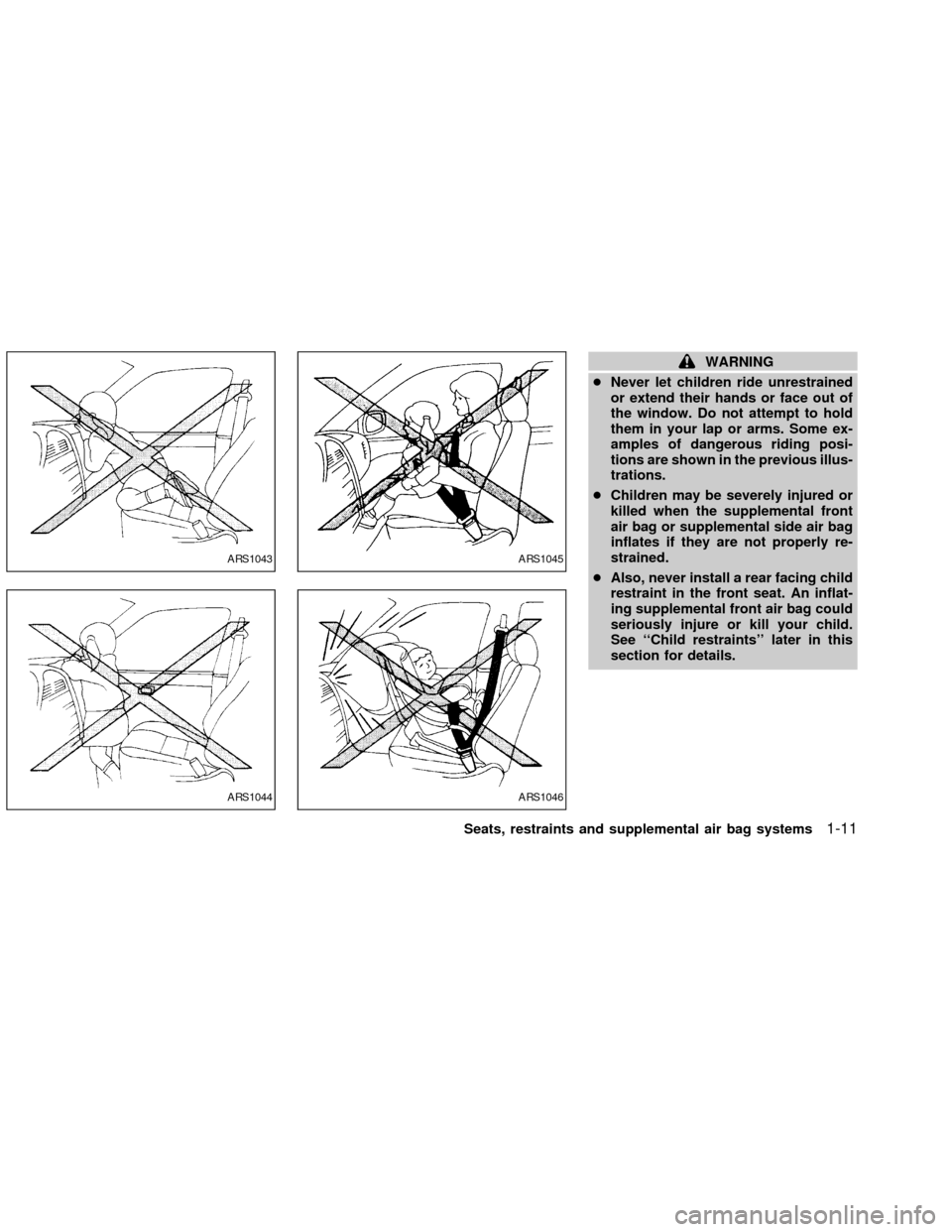
WARNING
cNever let children ride unrestrained
or extend their hands or face out of
the window. Do not attempt to hold
them in your lap or arms. Some ex-
amples of dangerous riding posi-
tions are shown in the previous illus-
trations.
cChildren may be severely injured or
killed when the supplemental front
air bag or supplemental side air bag
inflates if they are not properly re-
strained.
cAlso, never install a rear facing child
restraint in the front seat. An inflat-
ing supplemental front air bag could
seriously injure or kill your child.
See ``Child restraints'' later in this
section for details.
ARS1043
ARS1044
ARS1045
ARS1046
Seats, restraints and supplemental air bag systems1-11
ZX
Page 19 of 249
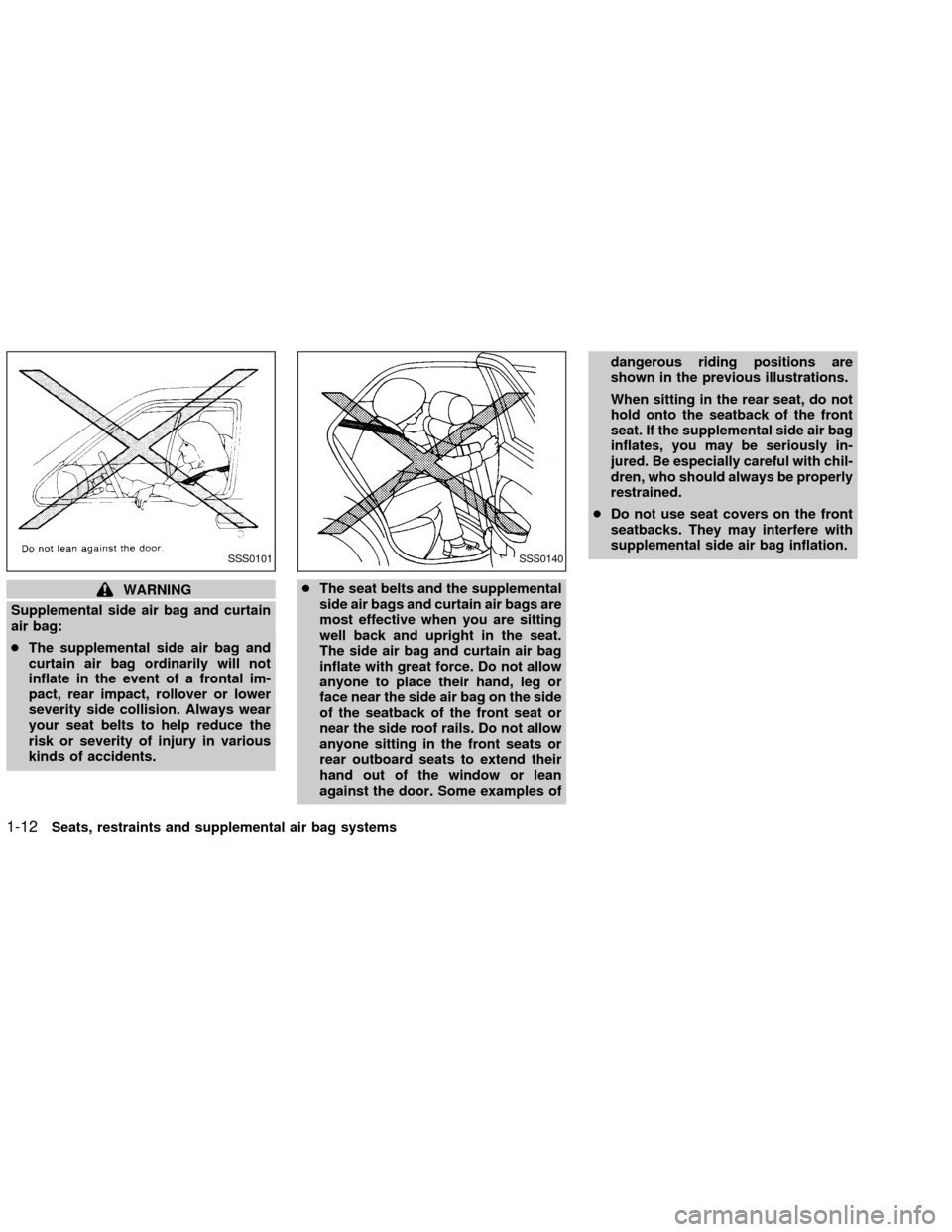
WARNING
Supplemental side air bag and curtain
air bag:
cThe supplemental side air bag and
curtain air bag ordinarily will not
inflate in the event of a frontal im-
pact, rear impact, rollover or lower
severity side collision. Always wear
your seat belts to help reduce the
risk or severity of injury in various
kinds of accidents.cThe seat belts and the supplemental
side air bags and curtain air bags are
most effective when you are sitting
well back and upright in the seat.
The side air bag and curtain air bag
inflate with great force. Do not allow
anyone to place their hand, leg or
face near the side air bag on the side
of the seatback of the front seat or
near the side roof rails. Do not allow
anyone sitting in the front seats or
rear outboard seats to extend their
hand out of the window or lean
against the door. Some examples ofdangerous riding positions are
shown in the previous illustrations.
When sitting in the rear seat, do not
hold onto the seatback of the front
seat. If the supplemental side air bag
inflates, you may be seriously in-
jured. Be especially careful with chil-
dren, who should always be properly
restrained.
cDo not use seat covers on the front
seatbacks. They may interfere with
supplemental side air bag inflation.
SSS0101SSS0140
1-12Seats, restraints and supplemental air bag systems
ZX
Page 20 of 249

SSS0159SSS0162
Seats, restraints and supplemental air bag systems1-13
ZX